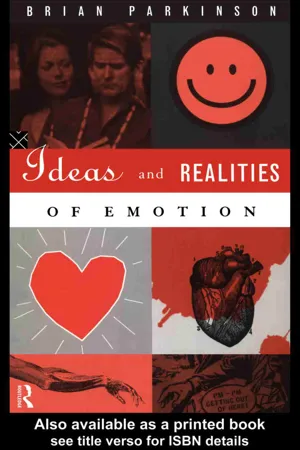Psychology
Lazarus Theory of Emotion
The Lazarus Theory of Emotion proposes that cognitive appraisal plays a crucial role in determining emotions. It suggests that emotions are the result of an individual's interpretation and evaluation of a situation, rather than being solely driven by physiological responses. According to this theory, the way a person appraises a situation influences the emotions they experience.
Written by Perlego with AI-assistance
Related key terms
5 Key excerpts on "Lazarus Theory of Emotion"
- eBook - ePub
- Brian Parkinson(Author)
- 2006(Publication Date)
- Routledge(Publisher)
The theory specifies what conclusions an individual must reach in order to be emotional but not how the individual reaches those conclusions. About the closest Lazarus ever came to characterizing exactly what happens during appraisal is captured in the following quotation from Lazarus and Folkman's (1984) book: Cognitive appraisal can be most readily understood as the process of categorizing an encounter, and its various facets, with respect to its significance for well-being. It is not information processing per se …, although it partakes of such processing. Rather, it is largely evaluative, focused on meaning or significance. (p. 31) According to this account, appraisal is a partly cognitive process resulting in the situation being classified according to its evaluated personal meaning. In his later writings (e.g. 1991a; 1991b), Lazarus explicitly broadened his idea of appraisal to include a range of possible cognitive and perceptual mechanisms. In the final section of this chapter I shall return to the question of what appraisal processes might involve in terms of cognitive (or emotional) activity. APPRAISAL AND EMOTIONAL DIFFERENTIATION The relationship between evaluation and emotion operates at the level of particular emotions as well as emotion in general. Different emotional states seem to imply characteristic judgements and appraisals. When you are experiencing guilt, for example, what you think and feel about what is happening to you is very different from what you think and feel when you are in love. Indeed, we often assume that the way in which we evaluate something can determine how we react to it emotionally. For instance, attention from someone to whom we are attracted produces a contrasting set of feelings to those produced by attention from someone we dislike or find disturbing - eBook - ePub
Review of Marketing Research
Volume 1
- Naresh Malhotra(Author)
- 2017(Publication Date)
- Routledge(Publisher)
how the purchase or consumption experience influences the nature of emotional response. Indeed, the same consumption experience can produce quite different emotional responses across consumers and even within the same consumer over time. Emotional response also seems at times to be at odds with rational or objective thought. This latter phenomenon raises questions about the relationship between cognition and emotion and the way(s) in which cognitive and emotional processes interact in consumers’ decisionmaking.Within the discipline of psychology, the study of emotion has sought to answer similar types of questions about the fundamental nature of emotion, while also seeking to parsimoniously represent the complex phenomenology of emotion across many different situations. In recent years, research in psychology has tended to converge on a group of related theories of emotion, known as appraisal theories, as a unifying approach to the study of emotion, because appraisal theories have provided the most convincing and comprehensive answers to date for key theoretical and practical questions about the nature of emotion (Ekman and Davidson 1994; Scherer, Schorr, and Johnstone 2001).Appraisal theories define emotion as a mental state that results from processing, or appraising, personally relevant information (e.g., Frijda 1993; Frijda, Kuipers, and ter Schure 1989; Lazarus and Smith 1988; Ortony, Clore, and Collins 1988; Roseman, Spindel, and Jose 1990; Scherer 1988; Smith and Ellsworth 1985). Appraisals are defined as the results of those information-processing tasks that indicate the implications of the situation for the interests and goals of the individual, and thereby determine the form that emotional reaction takes in a given situation. Thus, appraising is the processing of information that leads to emotional response, while appraisals are the “conclusions” that are reached through processing, which define the tenor of the emotion experienced (Lazarus 2001). For example, the most basic task of appraising is to determine whether a situation is “good” or “bad” for the individual in terms of his or her goals, and the resulting appraisals are part of either a positive or a negative emotion. Appraisal theories specify a number of dimensions of the appraisal process that further differentiate emotional reactions—in addition to simply feeling “good” or “bad”—based on an individual’s unique construction of the situation, and identify the process(es) by which emotional responses occur and are experienced by the individual. - eBook - ePub
- Catherine Pelachaud(Author)
- 2013(Publication Date)
- Wiley-ISTE(Publisher)
These theories have also been highly useful for understanding intra- and interpersonal differences, notably cultural and social, in the triggering and differentiation of emotions. 1.5.3. Criticisms of appraisal theories of emotion The main criticism of these theories is their potentially excessive cognitivism. As such, while researchers opposed to this approach accept that appraisal theories explain specific types of emotional reaction, they deny the necessity of this process and propose that in a number of cases emotions are produced by non-cognitive factors [BER 93, LED 93, OHM 78, ZAJ 84]. A key question concerning the “emotion/cognition” debate lies in the definition of the term “cognition” (see the glossary in section 1.7). If we accept that appraisal can occur rapidly on several cognitive levels, including automatic and unconscious processes, then the criticism of excessive cognitivism no longer holds up (see [LEV 87] for their proposition of levels of processing in the appraisal process [MOO 09, MOO 10, ROB 09]). Another criticism of these theories concerns emotional disorders. For example, for a sufferer of arachnophobia, acquiring the explicit knowledge that a spider is harmless does not stop them from being scared [GRI 04]. The notion of levels of processing therefore seems equally important for responding to this criticism. However, it should be noted that this “multi-level” approach to the appraisal process has also been criticized because the levels proposed could be seen as being too diverse to cover the general concept of appraisal [GRI 04] - eBook - ePub
Women's Anger
Clinical and Developmental Perspectives
- Deborah Cox, Sally Stabb, Karin Bruckner(Authors)
- 2016(Publication Date)
- Routledge(Publisher)
Lewis’s (1993) position, Dodge argues that (a) all cognition is emotional, in the sense that all processing occurs with some level of arousal and energy; (b) the goal directing aspect of emotion drives attentional processes; and (c) our phenomenological experience of emotion can alter interpretation and vice-versa. In other words, as we reflect upon what we want to change or obtain, we attend to those things affectively and cognitively. We both think and feel about them simultaneously. Thus, Dodge sees cognition and emotion as integrated with each other but gives prominence to cognitive information processing as the basis for emotion.Stein, Trabasso, and Liwag (1993) present a cognitive appraisal model of emotion that is knowledge-based and situated, by which the authors mean that it explores the content of emotions, as well as conditions that elicit emotion, and plans or actions carried out in response to emotional reactions. Stein and colleagues assume that people have the ability to act intentionally and are goal-directed. People assess and monitor the status of their goals, particularly those with a high degree of salience or meaning to them. In this model, we have an emotion if our preestablished schemas about those goals do not match new information we receive. This mismatch triggers both a cognitive evaluation process and ANS arousal, which together constitute emotion.Taking a cross-cultural perspective on appraisal Ellsworth (1994) proposes that cultural differences in reported emotion can be explained by variation in how people appraise situations across cultures. She identifies a series of basic appraisal dimensions: attention/novelty (a change in the environment), valence/pleasantness (is the change positive or negative?), agency/control (can I do anything about it?), and norm/self compatiblity (have I lived up to or fallen short of some standard of my community or myself?). Different cultures encourage different interpretations of social situations along these dimensions, which most likely result in different emotions. This idea echoes in the work of Frijda and Mesquita (1994) - eBook - ePub
- Paul Thagard(Author)
- 2010(Publication Date)
- Princeton University Press(Publisher)
People have a penchant for simple linear causal explanations: factor A causes factor B, which causes factor C. But biological systems often involve extensive causal interactions based on feedback, so that A and B interact to cause C, which then has a causal influence on A. For example, your liver function and diet both increase your cholesterol level, which then induces your liver to produce less cholesterol. Understanding how the brain produces emotions requires appreciating the complex of reciprocal connections shown in figure 5.2, producing highly nonlinear processes because of all the feedback that occurs. Although bodily perception theories of emotion have become popular in recent years, they fail to account for the full range of emotional phenomena. There are only weak correlations between emotions such as anger and fear and physiological states such as facial behavior and autonomic arousal. The subtle differences between diverse emotions have not been found to be closely related to distinct physiological states, their magnitudes, or particular neurotransmitters. Surgical disruption of bodily signals does not eliminate emotional reactions. Manipulations of physiology by injection of epinephrine can produce different emotional reactions depending on how people interpret their social situations. Social emotions such as guilt and pride require an appreciation of one's location in a social network. Hence cognitive appraisal is needed to complement bodily perception to generate a full range of emotional reactions. However, bodily perception remains a crucial part of the EMOCON model, which assumes that appraisal alone would not produce the kinds of feelings that occur in emotional consciousness. Figure 5.2 shows how integration of cognitive appraisal and bodily perception might work by virtue of the interactions among the amydgala, the insula, and several parts of the prefrontal cortex
Learn about this page
Index pages curate the most relevant extracts from our library of academic textbooks. They’ve been created using an in-house natural language model (NLM), each adding context and meaning to key research topics.




